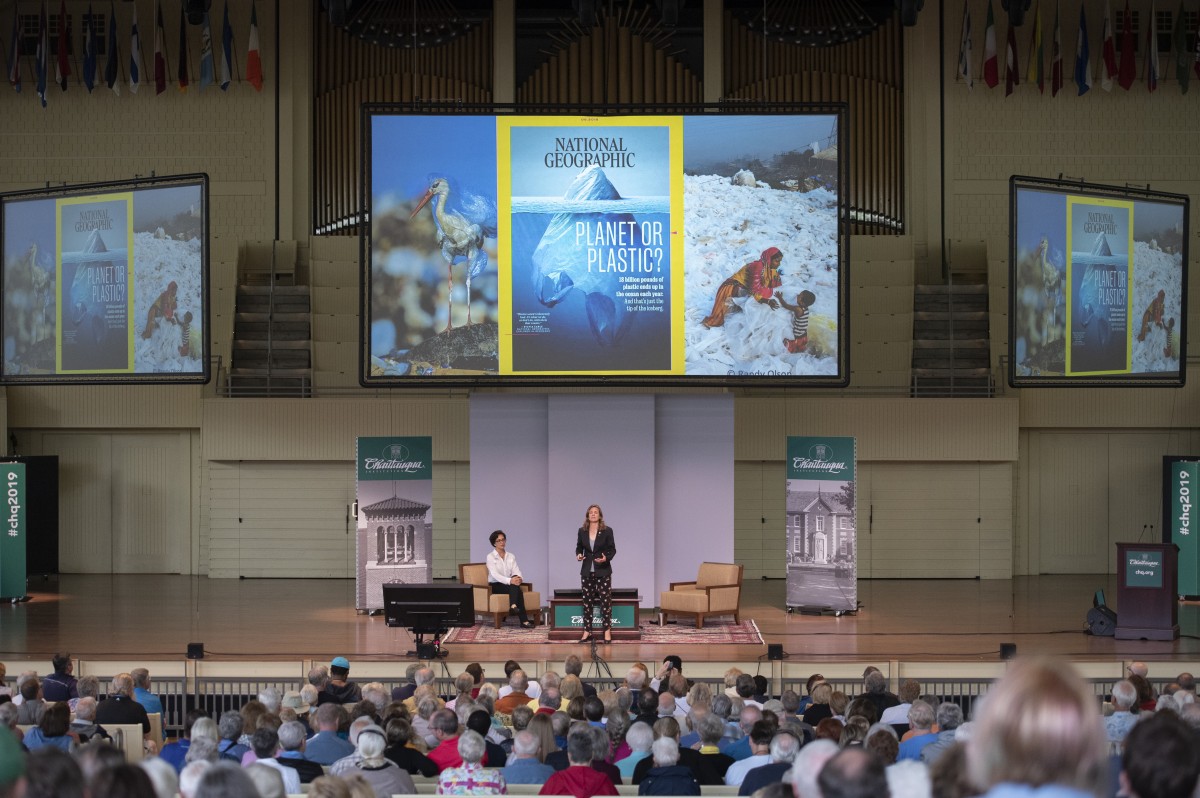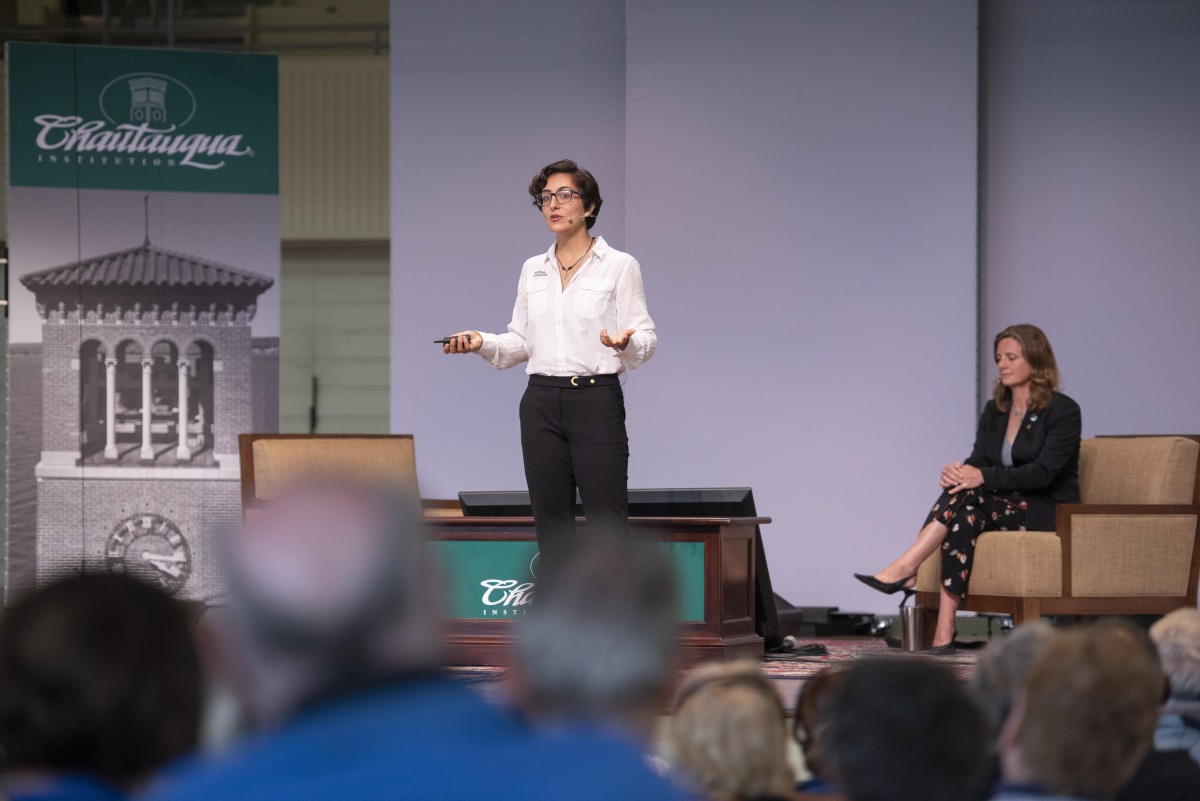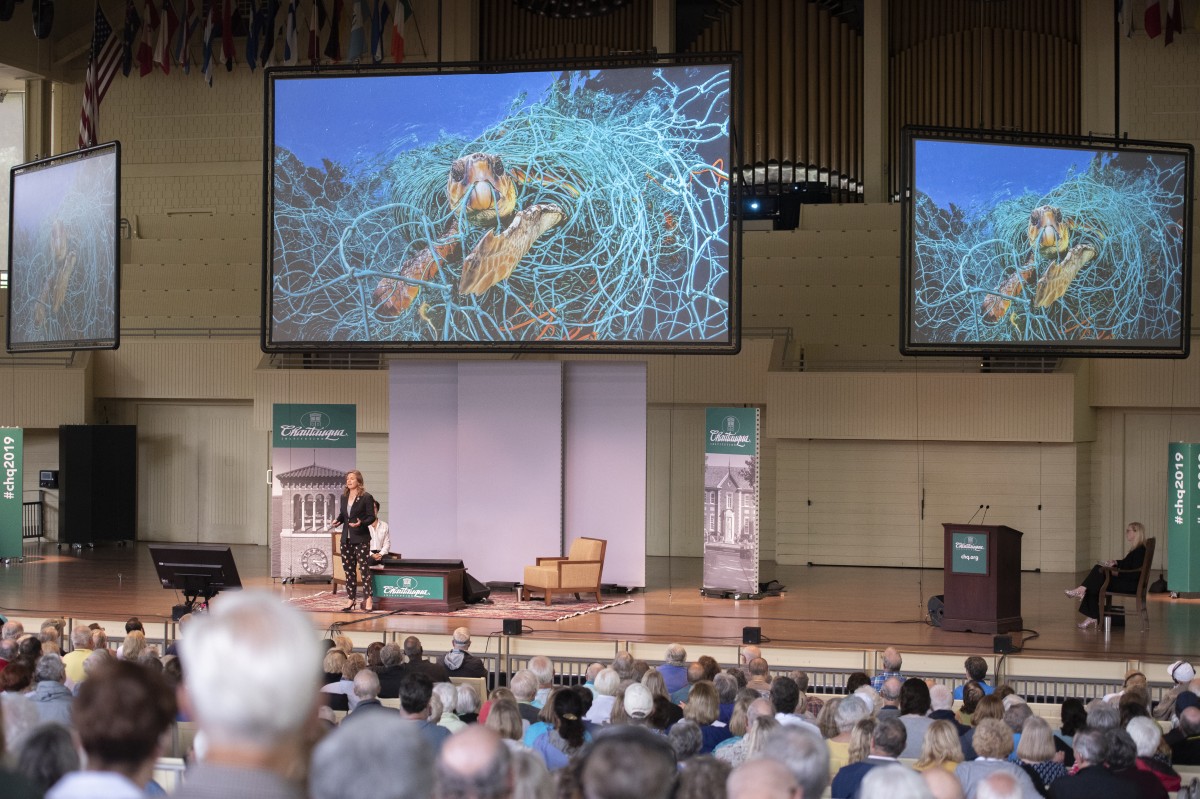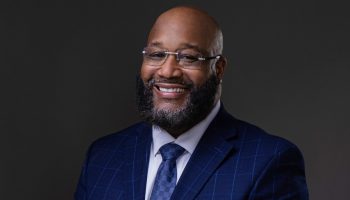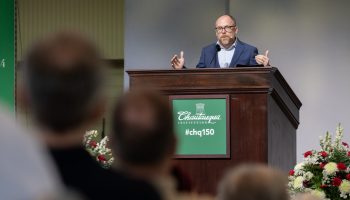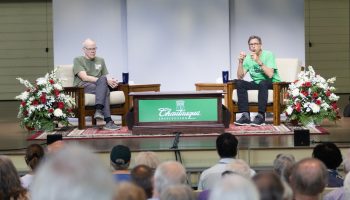On Friday morning, Heather Koldewey shared with her audience a photo she described as fragile, extraordinary and strangely beautiful.
It was a seahorse clutching a cotton swab with its tail — an image that’s remarkable, but also “very, very wrong.”
@HeatherKoldewey begins by speaking on her work with seahorses. #CHQ2019 pic.twitter.com/1xZva6BepV
— The Chautauquan Daily (@chqdaily) July 12, 2019
Koldewey, the Zoological Society of London’s senior technical adviser and National Geographic Fellow, and Lillygol Sedaghat, multimedia journalist and National Geographic Explorer, spoke at 10:45 a.m. Friday in the Amphitheater, closing Week Three, “A Planet in Balance: A Week in Partnership with National Geographic Society.”
Koldewey has studied seahorses for more than 20 years and said the species is “on the frontlines” of a planet in balance because millions of seahorses, like many other species, are captured for trade, aquariums and modern medicine every year.
“As fishing increases and the fish decrease, the amount of nets people are using to catch those fish also increases,” Koldewey said. “We are seeing a real spiral of declining fish for people to eat and increasing nets, which are essentially plastic.”
All over the world, 640,000 metric tons of fishing nets are discarded into the ocean annually. The nets are made of plastic and take at least 650 years to break down.
Koldewey has studied the impact of fishing nets in the Philippines, a center of biodiversity where the human population, living in extreme poverty, is entirely dependent on the ocean to survive.
But it’s not just nets that are a problem. The Philippine islands also lack a waste management system.
There is hope. There is a way to recycle those nets, and reuse them for nylon projects like carpets and clothes. pic.twitter.com/oE8zOOiWAJ
— The Chautauquan Daily (@chqdaily) July 12, 2019
“There is no garbage truck that turns up to take the waste away,” she said. “So, what I have been seeing in my 20-plus years working there, are these becoming, slowly but surely, islands of waste.”
Seeing the accumulating waste in person gave life to a daunting statistic: By 2025, there is projected to be 1 ton of plastic for every 3 tons of fish.
However, because one person’s trash is another person’s treasure, Koldewey said there is hope on the horizon. Through her award-winning program, Net-Works, the plastic fish netting is being recycled into nylon yarn that can be used for carpet tiles and clothing.
“We see the visual change,” she said. “Because we are science-based, we’ve been monitoring the beaches, the environment and seeing a dramatic transition as the waste nets now have somewhere to go. They now no longer get left anywhere because there’s value in the system and a supply chain to ship them.”
Since starting the Net-Works project in 2016, more than 224 metric tons of netting have been recycled, enough to go around the world five times.
The interconnectedness of oceans makes it hard to consider the improvement in the Philippines a dent in the plastic epidemic. Koldewey visited British-Indian territory made up of 55 uninhabited islands. Even though no one lived there, she picked up 334 single-use plastic water bottles in 20 minutes.
“This really summarized, to me, the fact that there is no ‘away’ for our waste,” she said. “What we do, what we choose to buy and how we choose to dispose of it has a huge impact on our planet, and particularly, on our ocean.”
Koldewey looked to London, where on average, every adult uses 175 single-use plastic water bottles a year. To understand the system that makes that possible, she studied human behavior, business, infrastructure, design, policy framework and how to normalize “green” behavior.
As a result of her research, water bottle refill centers were placed around the city. She also worked with sports centers, schools and businesses to reduce plastic waste.
Her children’s school is now plastic free and a refillable water bottle is part of their school uniform.
“We are looking at change happening across our community,” Koldewey said. “The future can look different.”
Through all of Koldewey’s case studies, Sedaghat said she noticed one similarity: “Change starts with ourselves.”
“The most powerful way to change something, to believe in an idea that you, in your own life, are willing to make a difference that inspires others, comes from a place of love,” Sedaghat said.
Sedaghat’s journey with plastic started with her Taiwanese milk tea obsession. Growing up, she always went to the same California tea shop, ordering drinks in single-use plastic cups, until she realized the consequences of her decisions.
“I realized that every single time I drink the drink that I love, I’m harming the environment that I love,” she said.
To better understand the plastic supply chain, Sedaghat went on a National Geographic trip to Taiwan, one of the world’s “geniuses in waste disposal” due to 148 circular economy initiatives and a 55% recycling rate.
In Taiwan, people separate their waste into recyclables, compost and trash. To dispose of trash, citizens are required to buy government-mandated trash bags and pay by weight, whereas composting and recycling are free.
The entire system was created by a group of housewives in 1987, when Taiwan transitioned into a democracy. At the same time, Taiwan had created a strong petrochemical plastics industry, but the byproduct of their economic growth was waste.
“That love for their family, for their community, that created nature as an extension of their whole family model, moved on to creating and piloting the first composting program,” Sedaghat said. “They completely banned Styrofoam from the food and beverage industry in Taiwan, … and then they also banned single-use disposable plastics from public offices and from schools. This group of women. Mothers. Love.”
@LillygolS speaks on the Homemakers United Foundation started in Taiwan. #CHQ2019 pic.twitter.com/NGjUXoFHNj
— The Chautauquan Daily (@chqdaily) July 12, 2019
In June 2018, National Geographic released an “iconic” issue: “Planet or Plastic?” Koldewey contributed to the magazine and the initiative with her study of plastic in rivers around the world.
“Rivers around the world are basically transporting waste through communities, through towns, through cities and ending up delivering plastic into the ocean,” Koldewey said.
Two months ago, Koldewey, along with an all-female team, went to the Ganges River in Bangladesh to design rapid assessment methodology to understand the source, flow and amount of plastic entering rivers. The team took samples from water and sediment; studied wildlife and how plastic affects the fish sold in markets; documented waste in communities; and hired a drone pilot to map the river bank and locate plastic entry points.
“But data is no good if you can’t use it, if you can’t take it and apply it to make change,” Koldewey said.
Sedaghat agreed, noting that impact only happens when data can be “humanized.”
Sedaghat went on an expedition to a basin located near the Ganges River and the Bay of Bengal, a region with the third-largest water disposal and the second-largest sediment load of all of the rivers in the world. She explored the region on a small wooden boat that gave her the proximity to understand the river’s role in the communities it flowed through.
“Being on a boat and understanding intimately, physically, what the river does to people — what it means to be entirely dependent and reliant on a source out of your control — helped us understand the plastics issue in the riverways with the communities and the livelihoods of the people there,” she said.
Along the river, Sedaghat met a community of people whose homes and land had washed away from river flooding in the monsoon season. Through that experience, she came to understand how the river is both loved and hated.
“It was appreciated and became an economic lifeline for thousands of people who relied on it for fishing, but it was also something that took — so intimately — directly from people’s lives,” she said. “At the same time, those people are just like us. They adapt to resources that are around them because what is most important is the love that they have for their children and for their families.”
It was during that trip that Sedaghat realized her choices and consumerist behavior in the United States affected millions of people, thousands of miles away. As she changed her habits, she came to understand the difference between having the capacity to change, and having the willpower to change.
@HeatherKoldewey shares ways in how London is improving the future. #CHQ2019 pic.twitter.com/2bPAlKmdVp
— The Chautauquan Daily (@chqdaily) July 12, 2019
“People had reached a certain socioeconomic level, a certain threshold of living where they no longer had to think about reusing, remaking, repairing certain materials,” she said. “You could just buy something new. That was a luxury that had come with coming into this next socioeconomic status and level.”
To conclude the lecture, Sedaghat offered localized solutions for communities that want to reduce waste.
First, one needs to understand the waste management system in their community.
“In your neighborhood, your school, your place of work — where does your trash go?” she asked. “What can and can’t be recycled? Who operates that system? Most of us put blind faith into a recycling bin without realizing how to recycle properly.”
Second, one must understand that recycling is a market, and they need to wash materials before recycling.
“The products that we put into that recycling bin have to compete with virgin materials in the market,” she said. “If they are contaminated by food waste, their quality is lower.”
Third, changing day-to-day decisions gives one the capacity to make a difference.
“That means, perhaps, bringing your own water bottle, bringing your own bamboo utensils, bringing your own straw, or a towel or a little bowl to carry with you,” she said. “Similar to the way that you would leave your home with your keys and your ID, why not make this a part of your day-to-day habits as well? Little choices make a huge impact.”
Fourth, think differently.
“We live and operate in a linear, industrial model where we take things from the Earth, we make them into something, we use them for one thing and then we throw them away,” Sedaghat said. “But what we need to really have a planet in balance is a circular way of thinking. We need to ask ourselves, ‘Where do these materials come from? Where do they go? Can I reuse them in any sort of way?’ ”
Although change starts with one person, worldwide change will come from a collective effort, Sedaghat said.
“Realizing that we are connected in our decisions here in the United States, with children thousands of miles away in Bangladesh, makes us feel that we are a part of something and that we can do something — starting today,” she said.
@LillygolS closes with this speech. #CHQ2019 pic.twitter.com/lRDGvc9MBK
— The Chautauquan Daily (@chqdaily) July 12, 2019


